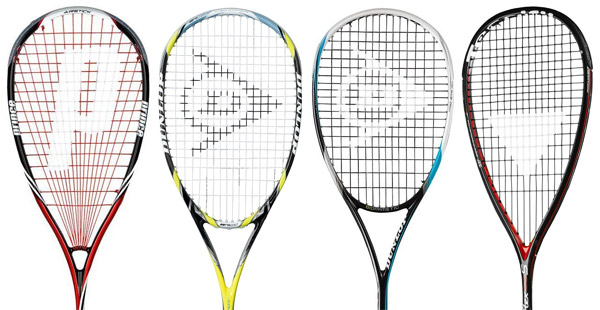Our Guide To Choosing Your Racket
The type of squash racket you play with can deeply impact your game. Balance, Weight, Throat Shape and Beam are all factors we need to consider before selecting the perfect racket to improve your game.
Racket Throat Shape

There are two types of racket throat which are referred to as Open or Closed. Usually, a closed throat is one that has a bridge at the top of the throat.
Classic throat squash rackets have a smaller string-bed and sweet spot. For this reason, the strings have less give. The trampoline effect, therefore, springs back with less force – and thus less variance. As a general rule, this racket will suit a more experienced player, one who already has a powerful swing, looking for enhanced control.
Open throat squash rackets sometimes known as Teardrop rackets have a larger string-bed area, a larger sweet spot, and therefore tend to be more forgiving and offer more power. Most of the top pros use teardrop-shaped rackets including Ali Farag (Dunlop Hyper fiber XT Revelation Pro), Nick Matthew (Dunlop Hyperfibre+ Evolution Pro), and Miguel Rodriguez (Tecnifibre Carboflex Cannonball), and Mohamed El Shorbagy and Marwan El Shorbagy (Tecnifibre Carboflex 125 Airshaft).
Racket Balance
Rackets can be head-light, head-heavy, or evenly balanced. When we talk about a racket being head heavy we are referring to the weight of the head being heavier than the shaft. An evenly balanced racket has a similar weighting in both the shaft and the head and lastly, a head-light racket has a heavier shaft and a lighter head.
Head-heavy rackets are easy to control whereas head-light rackets offer great maneuverability for a fast-paced game but can be harder to control at speed. As today’s game has become so fast-paced with plenty of quick volleys and attacking play many Pro players have started opting for head-light frames.

Racket Weight
Squash rackets generally weigh 110 – 145g. The weights marked on the racket frames are usually the unstrung weights and are often before paint, grommets and the grip are added so expect your actual racket to weigh a few grams more.
The unstrung weight is often included in the product title e.g Wilson Hammer 110. A lighter-weight racket will suit a more attacking player as it can be maneuvered quickly. Lighter rackets can also be great for juniors who want to play with a full-size racket without being weighed down. Heavier weight rackets suit a more traditional style player with a slower swing.
Racket Beam
Beam width (measured in millimeters) represents the thickness of the racket frame. The measurement is taken as the width of the racket when viewed from the side. Rackets with a thicker (wider) beam width are usually stiffer and more powerful due to the extra material in the frame, while rackets with a thinner (narrower) beam width offer greater maneuverability, flexibility, and feedback. The beam width of squash rackets is generally between 16-21mm.
Narrow Beams (16-17mm), offer greater maneuverability and are generally suited to skilled players.
Average beam (18-19 mm), rackets have a beam width within this range, which is suited to the majority of players.
Wide beams (20-21 mm), are recommended for less skilled players

Racket Stiffness
The stiffness of a racket frame is measured by its ability to flex on its longitudinal axis. Stiffer rackets bend less on contact with the ball, absorbing less impact energy from the ball and resulting in greater power. Flexible rackets bend more, leading to greater energy loss from the ball and reduced power, with an increased dwell time on the string bed during impact.
The material of a racket frame has the biggest overall effect on stiffness. The majority of squash rackets are made from (or contain) graphite. Some composite graphite rackets are hybrids with materials such as titanium to increase frame stiffness, providing greater power at a lighter weight.
Aluminum rackets are stiffer, more durable, and often significantly heavier than graphite rackets. The rackets are usually cheaper and advisable for beginners as they are more likely to withstand repeated contact with the walls and floor. They absorb less vibration from shots compared with graphite frames so are not advisable for people with elbow injuries.
